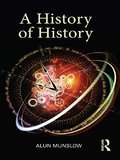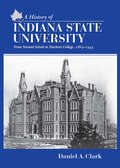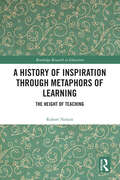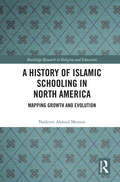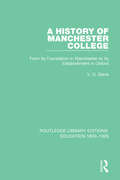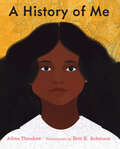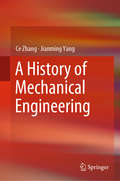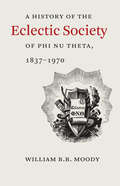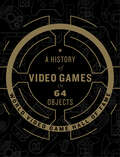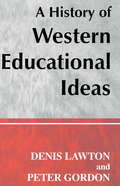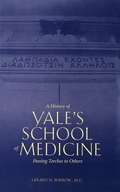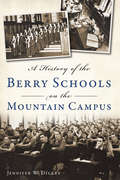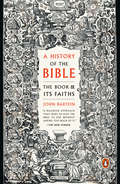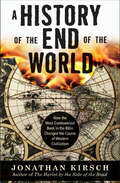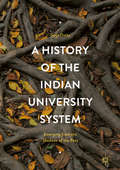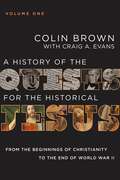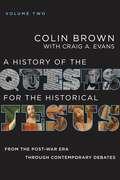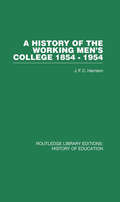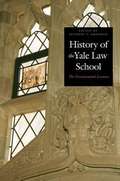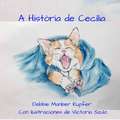- Table View
- List View
A History of History
by Alun MunslowIn a provocative analysis of European and American historical thinking and practice since the early 18th century, A History of History confronts several basic assumptions about the nature of history. Among these are the concept of historical realism, the belief in representationalism and the idea that the past possesses its own narrative. What is offered in this book is a far-reaching and fundamental rethinking of realist and representationalist ‘history of a particular kind’ by addressing and explaining the ideas of major philosophers of history over the past three hundred years and those of the key theorists of today. In pursuing this radical analysis, the understanding of history as a narrative is evaluated along with contemporary notions such as the continuing presence of the past and the idea of ‘its lessons’. Written by one of the leading thinkers on the subject, A History of History provides an accessible and radical history of history while offering new insights into the pressing questions of the nature, purpose and function of history. This book is an essential text for all students, teachers and consumers of history.
A History of Indiana State University: From Normal School to Teachers College, 1865-1933
by Dan ClarkIn 1865, Indiana State University began classes as many other future regional state universities would: as a "normal school," a school that specialized in training teachers, usually in one- or two-year programs. By 1933, Indiana State had won the name Teachers College and had begun offering graduate-level education. In A History of Indiana State University, Dan Clark explores the history of Indiana State's institutional transformation against the backdrop of the amazing expansion of public education and the scope of higher education in the United States during this period. Starting with the origins of the normal school and the need for professional teachers to help construct the educational infrastructure of Indiana, Clark examines how the faculty and students pushed the school to conform to increasingly popular traditional collegiate ideals, broadening their curriculum and student extracurricular life (athletics and Greek life), until by the 1920s Indiana State had transformed itself into a teachers college. A History of Indiana State University offers an invaluable guide to the history of this beloved Indiana institution, and details the underappreciated impact that normal schools had in providing an educational opportunity to less privileged aspiring students.
A History of Inspiration through Metaphors of Learning: The Height of Teaching (Routledge Research in Education)
by Robert NelsonIn this book, Robert Nelson reminds us that one of the most important elements of teaching and learning is to inspire and to be inspired. Given that inspiration itself has evolved through metaphor, the inquiry distinguishes inspirational learning by its peculiarly metaphoric character. We acknowledge that students respond to passion and enthusiasm, that they seek stimulation, purpose, motivation and inspiration. But because these triggers operate through mysterious language and arrive at their modern usage through metaphor, we have no means of penetrating their structure or gaining access to their powers. We mishandle educational practice through a focus on technical process and machinery rather than the imaginary animating vision that propagates inspired study through metaphor. This book corrects the imbalance and argues that metaphors are intrinsic to all our educational ambitions. It reveals the wide metaphorical backdrop of learning and teaching that works on an unconscious level and is only revealed through analysing the language that describes what matters most. Inviting readers to explore learning in a non-traditional way, this book will be of interest to researchers and students in education seeking to understand better the nature of inspiration.
A History of Islamic Schooling in North America: Mapping Growth and Evolution (Routledge Research in Religion and Education)
by Nadeem A. MemonThis insightful text challenges popular belief that faith-based Islamic schools isolate Muslim learners, impose dogmatic religious views, and disregard academic excellence. This book attempts to paint a starkly different picture. Grounded in the premise that not all Islamic schools are the same, the historical narratives illustrate varied visions and approaches to Islamic schooling that showcase a richness of educational thought and aspiration. A History of Islamic Schooling in North America traces the growth and evolution of elementary and secondary private Islamic schools in Canada and the United States. Intersecting narratives between schools established by indigenous African American Muslims as early as the 1930s with those established by immigrant Muslim communities in the 1970s demonstrate how and why Islamic Education is in a constant, ongoing process of evolution, renewal, and adaptation. Drawing on the voices, perspectives, and narratives of pioneers and visionaries who established the earliest Islamic schools, chapters articulate why Islamic schools were established, what distinguishes them from one another, and why they continue to be important. This book will be of great interest to graduate and postgraduate students, researchers, academics, teaching professionals in the fields of Islamic education, religious studies, multicultural education curriculum studies, and faith-based teacher education.
A History of Manchester College: From its Foundation in Manchester to its Establishment in Oxford (Routledge Library Editions: Education 1800-1926 #3)
by V. D. DavisThis book, first published in 1932, tells the progress of Manchester College, founded in Manchester in 1786, and since 1889 established at Oxford, as a postgraduate School of Theology and place of training for the ministry of religion. This title will be of interest to students of history and education.
A History of Me
by Adrea TheodoreAn uplifting message of hope for the future and pride in your history, inspired by a mother's experience of being the only Black child in her classroom.Who do you see when you look in the mirror? Emphasizing the strength, creativity, and courage passed down through generations, A History of Me offers a joyful new perspective on how we look at history and an uplifting message for the future. Being the only brown girl in a classroom full of white students can be hard. When the teacher talks about slavery and civil rights, she can feel all the other students' eyes on her. In those moments she wants to seep into the ground, wondering, is that all you see when you look at me? Having gone through the same experiences, the girl's mother offers a different, empowering point of view: she is a reflection of the powerful women that have come before her, of the intelligence, resilience, and resourcefulness that have been passed down through the generations. Her history is a source of pride, a reason to sit up straight and recognize everything beautiful and powerful in herself. What really matters is what we see when we look in the mirror, and what we want to become. Inspired by the authors' experiences in school and as a parent, Adrea Theodore&’s debut picture book is a powerful testament to the past as well as a benediction for the future. Erin Robinson's digital illustrations feature a wealth of texture and a bold, saturated palette, bringing this warm message of empowerment to life. A Junior Library Guild Gold Standard Selection
A History of Mechanical Engineering
by Jianming Yang Ce ZhangThis book explores the history of mechanical engineering since the Bronze Age. Focusing on machinery inventions and the development of mechanical technology, it also discusses the machinery industry and modern mechanical education. The evolution of machinery is divided into three stages: Ancient (before the European Renaissance), Modern (mainly including the two Industrial Revolutions) and Contemporary (since the Revolution in Physics, especially post Second World War). The book not only clarifies the development of mechanical engineering, but also reveals the driving forces behind it – e.g. the economy, national defense and human scientific research activities – to highlight the links between technology and society; mechanical engineering and the natural sciences; and mechanical engineering and related technological areas.Though mainly intended as a textbook or supplemental reading for graduate students, the book also offers a unique resource for researchers and engineers in mechanical engineering who wish to broaden their horizons.
A History of The Eclectic Society of Phi Nu Theta, 1837-1970
by William B. B. MoodyThe definitive record of the history, lore, and lost secrets of the Eclectic Society at Wesleyan University from its inception in 1837 through a great period of upheaval in the 1960s. The Society was founded in 1837 at Wesleyan, making it one of the oldest college fraternal organizations in the United States.
A History of Video Games in 64 Objects
by World Video Game Hall of FameInspired by the groundbreaking A History of the World in 100 Objects, this book draws on the unique collections of The Strong museum in Rochester, New York, to chronicle the evolution of video games, from Pong to first-person shooters, told through the stories of dozens of objects essential to the field’s creation and development.Drawing on the World Video Game Hall of Fame’s unmatched collection of video game artifacts, this fascinating history offers an expansive look at the development of one of the most popular and influential activities of the modern world: video gaming.Sixty-four unique objects tell the story of the video game from inception to today. Pithy, in-depth essays and photographs examine each object’s significance to video game play—what it has contributed to the history of gaming—as well as the greater culture.A History of Video Games in 64 Objects explains how the video game has transformed over time. Inside, you’ll find a wide range of intriguing topics, including:The first edition of Dungeons & Dragons—the ancestor of computer role-playing gamesThe Oregon Trail and the development of educational gamingThe Atari 2600 and the beginning of the console revolutionA World of Warcraft server blade and massively multiplayer online gamesMinecraft—the backlash against the studio systemThe rise of women in gaming represented by pioneering American video game designers Carol Shaw and Roberta Williams’ game development materialsThe prototype Skylanders Portal of Power that spawned the Toys-to-Life video game phenomenon and shook up the marketplaceAnd so much more!A visual panorama of unforgettable anecdotes and factoids, A History of Video Games in 64 Objects is a treasure trove for gamers and pop culture fans. Let the gaming begin!
A History of Wayne State University in Photographs
by Bill Mcgraw Evelyn Aschenbrenner Charles K. HydeShowcases the founding, development, and growth of Wayne State University, Michigan's third largest public university, in historical photographs.
A History of Wayne State University in Photographs, Second Edition
by Evelyn Aschenbrenner M. Roy WilsonWayne State University traces its earliest roots to the Civil War era and Detroit's Harper Hospital, where its Medical College was founded in 1868. In 1917, a junior college was formed in the building now called Old Main and along with four other schools—education, engineering, pharmacy, and a graduate school—these units would come to be called Wayne State University (WSU). The second edition of A History of Wayne State University in Photographs traces the evolution of those early schools into a modern research university with an extensive urban campus. Following the first edition, author Evelyn Aschenbrenner uses historical photos and archival material to give readers a complete visual guide to Wayne State University’s development, including an update of the last ten years—just in time for WSU’s 150th anniversary. She charts official milestones of the university, including the organization of colleges into a university in the 1930s, the drive for state support in the 1950s, and the new buildings constructed as academic programs expanded. Aschenbrenner also surveys campus life, including disciplinary and curricular development, student life, and the university’s relations with its surrounding neighborhood, which were strained by various urban renewal programs. The second edition retains the thoughtful introduction by Charles K. Hyde and original foreword by Bill McGraw, who was a student at WSU in the late 1960s and early 1970s. In a new foreword, President M. Roy Wilson argues that anniversaries like our sesquicentennial are special because "they give us something that is hard to get during the normal work week: perspective." The second edition of A History of Wayne State University in Photographs compiles rare and intriguing images that will be make a perfect keepsake for current and former students, faculty and staff, and anyone interested in Detroit history.
A History of Western Educational Ideas (Woburn Education Series)
by Professor Peter Gordon Professor Denis LawtonIt is important that all those concerned with education - parents, teachers, administrators and policymakers - should have a reasonable understanding of the present system and how it has developed, sometimes over a period of many years. This work traces the development of Western educational ideas from the Greek society of Socrates, Plato and Aristotle, to the ideas and ideologies behind some of the controversial issues in education today.This book discusses the continuous development of educational thought over three millennia. The focus upon the history of ideas in this volume is partly an attempt to move history of education away from an approach based on 'great men' to technological, economic and political influences on ideas and beliefs. It reviews many issues, ranging from the purposes of education from the earliest times, to the challenge of postmodernism in the present century. The authors provide an accessible and thought-provoking guide to the educational ideas that underlie practice.
A History of Yale's School of Medicine: Passing Torches to Others
by Gerard N. BurrowThis is a story of the Yale University School of Medicine starting from its origin to its present.
A History of the Berry Schools on the Mountain Campus
by Jennifer DickeyAt the dawn of the twentieth century, Martha Berry had a vision that a residential school for young men and women with limited educational opportunities would help break the cycle of poverty that pervaded the rural South. She began an educational experiment in northwest Georgia that unfolded during her lifetime and continues into the twenty-first century. This book tells the story of a part of that school--the high school that existed on the Mountain Campus at Berry for more than six decades. For the students who were educated there, the school was transformative. As one alumnus explained, the school had about it an "intangible magic." Join author and Berry Academy alumna Jennifer Dickey as she captures the spirit of that school that today lives on in the "head, heart and hands" of its graduates.
A History of the Bible: The Story of the World's Most Influential Book
by John BartonA literary history of our most influential book of all time, by an Oxford scholar and Anglican priestIn our culture, the Bible is monolithic: It is a collection of books that has been unchanged and unchallenged since the earliest days of the Christian church. The idea of the Bible as "Holy Scripture," a non-negotiable authority straight from God, has prevailed in Western society for some time. And while it provides a firm foundation for centuries of Christian teaching, it denies the depth, variety, and richness of this fascinating text. In A History of the Bible, John Barton argues that the Bible is not a prescription to a complete, fixed religious system, but rather a product of a long and intriguing process, which has inspired Judaism and Christianity, but still does not describe the whole of either religion. Barton shows how the Bible is indeed an important source of religious insight for Jews and Christians alike, yet argues that it must be read in its historical context--from its beginnings in myth and folklore to its many interpretations throughout the centuries. It is a book full of narratives, laws, proverbs, prophecies, poems, and letters, each with their own character and origin stories. Barton explains how and by whom these disparate pieces were written, how they were canonized (and which ones weren't), and how they were assembled, disseminated, and interpreted around the world--and, importantly, to what effect. Ultimately, A History of the Bible argues that a thorough understanding of the history and context of its writing encourages religious communities to move away from the Bible's literal wording--which is impossible to determine--and focus instead on the broader meanings of scripture.
A History of the End of the World: How the Most Controversial Book in the Bible Changed the Course of Western Civilization
by Jonathan Kirsch"[The Book of] Revelation has served as a "language arsenal" in a great many of the social, cultural, and political conflicts in Western history. Again and again, Revelation has stirred some dangerous men and women to act out their own private apocalypses. Above all, the moral calculus of Revelation—the demonization of one's enemies, the sanctification of revenge taking, and the notion that history must end in catastrophe—can be detected in some of the worst atrocities and excesses of every age, including our own. For all of these reasons, the rest of us ignore the book of Revelation only at our impoverishment and, more to the point, at our own peril."The mysterious author of the Book of Revelation (or the Apocalypse, as the last book of the New Testament is also known) never considered that his sermon on the impending end times would last beyond his own life. In fact, he predicted that the destruction of the earth would be witnessed by his contemporaries. Yet Revelation not only outlived its creator; this vivid and violent revenge fantasy has played a significant role in the march of Western civilization. Ever since Revelation was first preached as the revealed word of Jesus Christ, it has haunted and inspired hearers and readers alike. The mark of the beast, the Antichrist, 666, the Whore of Babylon, Armageddon, and the Four Horsemen of the Apocalypse are just a few of the images, phrases, and codes that have burned their way into the fabric of our culture. The questions raised go straight to the heart of the human fear of death and obsession with the afterlife. Will we, individually or collectively, ride off to glory, or will we drown in hellfire for all eternity? As those who best manipulate this dark vision learned, which side we fall on is often a matter of life or death. Honed into a weapon in the ongoing culture wars between states, religions, and citizenry, Revelation has significantly altered the course of history. Kirsch, whom the Washington Post calls "a fine storyteller with a flair for rendering ancient tales relevant and appealing to modern audiences," delivers a far-ranging, entertaining, and shocking history of this scandalous book, which was nearly cut from the New Testament. From the fall of the Roman Empire to the Black Death, the Inquisition to the Protestant Reformation, the New World to the rise of the Religious Right, this chronicle of the use and abuse of the Book of Revelation tells the tale of the unfolding of history and the hopes, fears, dreams, and nightmares of all humanity.
A History of the Humanities in the Modern University: A Productive Crisis
by Sverre RaffnsøeThis book challenges commonplace assertions that the humanities are presently undergoing a severe crisis as a result of a longstanding decline. Rather than hearkening to the widespread, reactive call for a last-ditch defense of the humanities under attack from an ungracious world, this book fundamentally reverses the perspective and makes a plea for a different, affirmative approach. It contends that the humanities have incessantly arrived at critical turning points since they were first constituted in a form that remains recognizable today and assumed a leading role in knowledge organization with the establishment of the modern university around 1800. Assuming a historical perspective, the monograph takes the human sciences back to their rightful place in the family tree of sciences and gives due recognition to their continuously decisive role in the production of new knowledge and the creation of new fields of knowledge. Situating the ongoing gemmation of the humanities in a broader context, this monograph also offers an encompassing introduction to the over-all development of knowledge in the last two hundred years.
A History of the Indian University System: Emerging from the Shadows of the Past
by Surja DattaThis book provides an explanation of the nature of the Indian university system, including its specificities and its peculiarities as well as exploring how they developed. It offers a historical and institutional perspective by singling out the forces that have shaped the present Indian higher education system. Bridging the pre-independence and the post-independence eras, the book illustrates the continuities as well as the differences between the two epochs. It makes a compelling case for the idea that history matters, and an understanding of India's history is crucial to understanding the present day Indian university scene. Using multiple paradigmatic case studies, based on the University of Calcutta, the Indian Institute of Science, and the Indian Statistical Institute, the book highlights the dominant ideologies and interests that have shaped the university system since its inception in 1857. It will be of great importance to students and scholars of history and education, particularly those with an interest in the history of India and its education system.
A History of the Quests for the Historical Jesus, Volume 1: From the Beginnings of Christianity to the End of World War II
by Colin Brown Craig A. EvansA comprehensive, two-volume reassessment of the quests for the historical Jesus that details their origins and underlying presuppositions as well as their ongoing influence on today's biblical and theological scholarship.Jesus' life and teaching is important to every question we ask about what we believe and why we believe it. And yet there has never been common agreement about his identity, intentions, or teachings—even among first-century historians and scholars. Throughout history, different religious and philosophical traditions have attempted to claim Jesus and paint him in the cultural narratives of their heritage, creating a labyrinth of conflicting ideas.From the evolution of orthodoxy and quests before Albert Schweitzer's famous "Old Quest," to today's ongoing questions about criteria, methods, and sources, A History of the Quests for the Historical Jesus not only chronicles the developments but lays the groundwork for the way forward.The late Colin Brown brings his scholarly prowess in both theology and biblical studies to bear on the subject, assessing not only the historical and exegetical nuts and bolts of the debate about Jesus of Nazareth but also its philosophical, sociological, and theological underpinnings. Instead of seeking a bedrock of "facts," Brown stresses the role of hermeneutics in formulating questions and seeking answers.Colin Brown was almost finished with the manuscript at the time of his passing in 2019. Brought to its final form by Craig A. Evans, this book promises to become the definitive history and assessment of the quests for the historical Jesus.Volume One covers the period from the beginnings of Christianity to the end of World War II.Volume Two (sold separately) covers the period from the post-War era through contemporary debates.
A History of the Quests for the Historical Jesus, Volume 2: From the Post-War Era through Contemporary Debates
by Colin Brown Craig A. EvansA comprehensive, two-volume reassessment of the quests for the historical Jesus that details their origins and underlying presuppositions as well as their ongoing influence on today's biblical and theological scholarship.Jesus' life and teaching is important to every question we ask about what we believe and why we believe it. And yet there has never been common agreement about his identity, intentions, or teachings—even among first-century historians and scholars. Throughout history, different religious and philosophical traditions have attempted to claim Jesus and paint him in the cultural narratives of their heritage, creating a labyrinth of conflicting ideas.From the evolution of orthodoxy and quests before Albert Schweitzer's famous "Old Quest," to today's ongoing questions about criteria, methods, and sources, A History of the Quests for the Historical Jesus not only chronicles the developments but lays the groundwork for the way forward.The late Colin Brown brings his scholarly prowess in both theology and biblical studies to bear on the subject, assessing not only the historical and exegetical nuts and bolts of the debate about Jesus of Nazareth but also its philosophical, sociological, and theological underpinnings. Instead of seeking a bedrock of "facts," Brown stresses the role of hermeneutics in formulating questions and seeking answers.Colin Brown was almost finished with the manuscript at the time of his passing in 2019. Brought to its final form by Craig A. Evans, this book promises to become the definitive history and assessment of the quests for the historical Jesus.Volume One (sold separately) covers the period from the beginnings of Christianity to the end of World War II.Volume Two covers the period from the post-War era through contemporary debates.
A History of the Rutgers University Glee Club
by David F. ChapmanFounded in 1872, the Glee Club is Rutgers University’s oldest continuously active student organization, as well as one of the first glee clubs in the United States. For the past 150 years, it has represented the university and presented an image of the Rutgers man on a national and international stage. This volume offers a comprehensive history of the Rutgers Glee Club, from its origins adopting traditions from the German Männerchor and British singing clubs to its current manifestation as a world-recognized ensemble. Along the way, we meet the colorful and charismatic men who have directed the group over the years, from the popular composer and minstrel performer Loren Bragdon to the classically-trained conductor Patrick Gardner. And of course, we learn what the club has meant to the generations of talented and dedicated young men who have sung in it. A History of the Rutgers University Glee Club recounts the origins of the group’s most beloved traditions, including the composition of the alma mater’s anthem “On the Banks of the Old Raritan” and the development of the annual Christmas in Carol and Song concerts. Meticulously researched, including a complete discography of the club’s recordings, this book is a must-have for all the Rutgers Glee Club’s many fans and alumni.
A History of the University in Europe
This is the final volume in a four-part series covering the development of the university in Europe (east and west) from its origins to the present day, focusing on a number of major themes viewed from a European perspective. The originality of the series lies in its comparative, interdisciplinary, collaborative and transnational nature. It deals also with the content of what was taught at the universities, but its main purpose is an appreciation of the role and structures of the universities as seen against a backdrop of changing conditions, ideas and values. This volume deals with the reconstruction and epoch-making expansion of higher education after 1945, which led to the triumph of modern science. It traces the development of the relationship between universities and national states, teachers and students, their ambitions and political activities. Special attention is paid to fundamental changes in the content of teaching at the universities.
A History of the Working Men's College: 1854-1954
by J F HarrisonOriginally published in 1954, this is the first full-length account of the history of the Working Men’s College in St.Pancras, London. One hundred and fifty years on from its foundation in 1854, it is the oldest adult educational institute in the country. Self-governing and self-financing, it is a rich part of London’s social history. The college stands out as a distinctive monument of the voluntary social service founded by the Victorians, unchanged in all its essentials yet adapting itself to the demands of each generation of students and finding voluntary and unpaid teachers to continue its tradition.
A History of the Yale Law School: The Tercentennial Lectures
by Anthony T. KronmanA fascinating examination of the history of the Yale Law School and its impact on the development of legal education in the U. S. The entity that became the Yale Law School started life early in the nineteenth century as a proprietary school, operated as a sideline by a couple of New Haven lawyers. The New Haven school affiliated with Yale in the 1820s, but it remained so frail that in 1845 and again in 1869 the University seriously considered closing it down. From these humble origins, the Yale Law School went on to become the most influential of American law schools. In the later nineteenth century the School instigated the multidisciplinary approach to law that has subsequently won nearly universal acceptance. In the 1930s the Yale Law School became the center of the jurisprudential movement known as legal realism, which has ever since shaped American law. In the second half of the twentieth century Yale brought the study of constitutional and international law to prominence, overcoming the emphasis on private law that had dominated American law schools. By the end of the twentieth century, Yale was widely acknowledged as the nation's leading law school. The essays in this collection trace these notable developments. They originated as a lecture series convened to commemorate the tercentenary of Yale University. A distinguished group of scholars assembled to explore the history of the School from the earliest days down to modern times. This volume preserves the highly readable format of the original lectures, supported with full scholarly citations.
A História de Cecília
by Sueli Astrini Debbie Manber KupferCecília está em busca de um novo humano, mas será que ela o encontrará ? Disseram que eles eram muito difíceis de treinar. Da autora de P.A.W.S. e Esmeralda Grunch and the Red Tulip.
